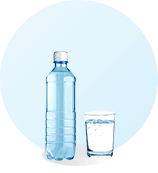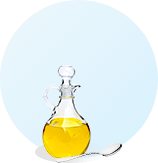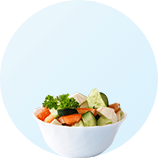
Intensive Level
In this level you will replace all 3 meals with OPTIFAST VLCD products. This level is designed for fast, effective weight loss. This level is the Very Low Calorie Diet (VLCD) part of the OPTIFAST VLCD Program. Research has shown weight loss on the Intensive level averages 1.0 to 2.5kg / week with an average total weight loss of 20kg after 12 to 16 weeks1,2.

How does it work?
On the Intensive Level you will replace all 3 meals with OPTIFAST VLCD products. This level provides up to 800 calories per day and is designed for fast weight loss via a metabolic reaction called 'ketosis'. In addition to the 3 OPTIFAST VLCD products, you will also have:
- ● At least 2 cups of low starch vegetables
- ● 1 teaspoon of vegetable oil
- ● 2 litres of water every day
IMPORTANT: Due to the energy restriction of under 800 calories per day, this Level is only to be followed by individuals with a BMI of 30kg/m2 or more, or 27-30kg/m2 with weight related co-morbidities such as diabetes, hypertension, high blood pressure, and high cholesterol. You must speak to your healthcare professional before commencing on the Intensive Level.
References:
1. Delbridge, E. and J. Proietto, State of the science: VLED (Very Low Energy Diet) for obesity. Asia Pacific Journal Clinical Nutrition, 2006. 15 (Suppl): p. 49-54.
2. Mustajoki, P. and T. Pekkarinen, Very low energy diets in the treatment of obesity. Obesity Reviews, 2001. 2: p. 61-72.
Inducing ketosis with the Intensive Level is an effective way to start your weight loss program
- Designed for rapid, initial, effective weight loss.
- Induces Ketosis.
- Stay on this phase from anywhere up to 12 weeks.
- If, after 12 weeks, you still have significant weight to lose, follow the Transition Phase for a minimum of 2 weeks before repeating the Intensive phase.
- Alternatively, seek advice by a Healthcare Professional on how to stay longer.
You also need to consume the below everyday to ensure a nutritionally balanced diet.

2 Litre Water

1 tsp Vegetable Oil

2 Cups low Starch Vegetables

Frequently Asked Questions
FAQ
Explain the OPTIFAST VLCD Program Intensive Level?
The Intensive Level of the OPTIFAST VLCD Program is the Very Low Calorie Diet part of the program. It is a total diet replacement providing less than 800 calories per day. This level is designed to achieve a large initial weight loss whilst helping to preserve lean body mass. The recommended time frame for this level is anywhere up to 12 weeks. The sources of nutrition during this level are 3 OPTIFAST VLCD products and two cups of low starch vegetables, plus one teaspoon of vegetable oil, providing less than 800 calories per day. Two litres of water should also be consumed each day. The Intensive Level of the OPTIFAST VLCD Program is designed to induce a mild ketosis to assist with weight loss.
Can I continue the Intensive Levl of the OPTIFAST VLCD Program for longer than 12 weeks?
On the OPTIFAST VLCD Program, the Intensive Level is recommended for up to 12 weeks, however if you still have more weight to lose after the initial 12 weeks and would like to stay on the Intensive Level a little longer, then it is very important that you consult your healthcare professional to see if this is suitable for you. It is also important to do this under their supervision. Alternatively, if there is still a significant amount of weight to be lost at the end of the initial 12 weeks, we recommend you follow the Active 2 Level for a minimum of two weeks before repeating the Intensive Level again.
Can I shorten (modify) the time I am on the OPTIFAST VLCD 12 week Intensive Level?
The Intensive Level is recommended for up to 12 weeks on the OPTIFAST VLCD Program, however you can transition to the next level when you are advised to do so by your healthcare professional, or when you decide you are ready to move on. It is recommended to see an Accredited Practicing Dietitian to help you transition and support you through the program. Try to refrain from transitioning sooner if you are experiencing some minor side-effects such as headaches, diarrhoea, fatigue or constipation. These symptoms are common and can be easily managed. Speak to your healthcare professional first so as they can advise how to overcome or correct these before coming off the program.
What food can I eat after I have completed the Intensive Level of the OPTIFAST VLCD Program?
After the Intensive Level of the OPTIFAST VLCD Program, you are ready to progress onto the Active 2 Level where the re-introduction of food takes place by replacing one OPTIFAST VLCD product with a calorie-controlled meal of approximately 350 calories. This should consist of a balanced meal of protein (eg. 65-100g meat or chicken, 130g fish, 2 eggs or 150g tofu), carbohydrates (1 cup cooked pasta, 3/4 cup cooked rice, 1 medium potato or corn cob, or 1-2 slices of bread), and half a plate of low starch vegetables or salad. Your two cups of low starch vegetable allowance can be incorporated into your low-calorie meal or if your calorie allowance allows, you can add it as extras to your meal plan. One tablespoon (20ml) of dressing or sauce can also be added to help flavour the meal. During the Active 2 Level you can also introduce a serve of fruit (70 calories) and a serve of dairy (100 calories).
What should I expect during the first week of the Intensive Level of the OPTIFAST VLCD Program?
As with any major dietary adjustment, the first few days on the OPTIFAST VLCD Program can be the hardest. The OPTIFAST VLCD Program is much easier to follow after the first few days due to a chemical reaction that occurs in your body, called ketosis. Although ketosis is a little uncomfortable to start with, it will eventually reduce your appetite and help manage your intake through the Intensive Level. The first few days on the OPTIFAST VLCD Program are commonly known as the 3 day challenge. As the body transitions into ketosis, you may experience some transient side effects such as; fatigue, hunger, lack of concentration, nausea, headaches. These are the result of a large change in your diet, including a decrease in overall food intake as well as carbohydrates, which are the body’s preferred source of energy. These side effects are generally only short-lived while your body adjusts to the change and most symptoms will pass by days 4-6. If you are concerned about any side affects you are experiencing, please see your healthcare professional.